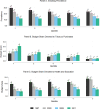Inequality of the crowding-out effect of tobacco expenditure in Colombia
- PMID: 38771837
- PMCID: PMC11108158
- DOI: 10.1371/journal.pone.0303328
Inequality of the crowding-out effect of tobacco expenditure in Colombia
Erratum in
-
Correction: Inequality of the crowding-out effect of tobacco expenditure in Colombia.PLoS One. 2024 Dec 12;19(12):e0315977. doi: 10.1371/journal.pone.0315977. eCollection 2024. PLoS One. 2024. PMID: 39666695 Free PMC article.
Abstract
In recent decades, policy initiatives involving increases in the tobacco tax have increased pressure on budget allocations in poor households. In this study, we examine this issue in the context of the expansion of the social welfare state that has taken place over the last two decades in several emerging economies. This study explores the case of Colombia between 1997 and 2011. In this period, the budget share of the poorest expenditure quintile devoted to tobacco products of smokers' households doubled. We analyse the differences between the poorest and richest quintiles concerning the changes in budget shares, fixing a reference population over time to avoid demographic composition confounders. We find no evidence of crowding-out of education or healthcare expenditures. This is likely to be the result of free universal access to health insurance and basic education for the poor. For higher-income households, tobacco crowds out expenditures on entertainment, leisure activities, and luxury expenditures. This finding should reassure policymakers who are keen to impose tobacco taxes as an element of their public health policy.
Copyright: © 2024 Gallego et al. This is an open access article distributed under the terms of the Creative Commons Attribution License, which permits unrestricted use, distribution, and reproduction in any medium, provided the original author and source are credited.
Conflict of interest statement
The authors have declared that no competing interests exist.
Figures



Similar articles
-
Crowding out and impoverishing effect of tobacco in Mexico.Tob Control. 2024 Jun 4;33(Suppl 2):s68-s74. doi: 10.1136/tc-2022-057791. Tob Control. 2024. PMID: 37567601 Free PMC article.
-
The health, financial and distributional consequences of increases in the tobacco excise tax among smokers in Lebanon.Soc Sci Med. 2016 Dec;170:161-169. doi: 10.1016/j.socscimed.2016.10.020. Epub 2016 Oct 20. Soc Sci Med. 2016. PMID: 27792922 Free PMC article.
-
Tobacco and household expenditure in Egypt: insights into socioeconomic inequalities and spending profiles from the Household Income, Expenditure and Consumption Survey.BMC Public Health. 2025 Feb 13;25(1):598. doi: 10.1186/s12889-025-21676-w. BMC Public Health. 2025. PMID: 39948505 Free PMC article.
-
The Impact of Tobacco Consumption on Rural Household Expenditure and Self-rated Health Among Rural Household Members in China.Subst Use Misuse. 2018 Oct 15;53(12):1974-1983. doi: 10.1080/10826084.2018.1449862. Epub 2018 Mar 26. Subst Use Misuse. 2018. PMID: 29578826
-
Equity impacts of price policies to promote healthy behaviours.Lancet. 2018 May 19;391(10134):2059-2070. doi: 10.1016/S0140-6736(18)30531-2. Epub 2018 Apr 5. Lancet. 2018. PMID: 29627166 Free PMC article. Review.
Cited by
-
Correction: Inequality of the crowding-out effect of tobacco expenditure in Colombia.PLoS One. 2024 Dec 12;19(12):e0315977. doi: 10.1371/journal.pone.0315977. eCollection 2024. PLoS One. 2024. PMID: 39666695 Free PMC article.
-
Crowding out and impoverishing effect of tobacco in Mexico.Tob Control. 2024 Jun 4;33(Suppl 2):s68-s74. doi: 10.1136/tc-2022-057791. Tob Control. 2024. PMID: 37567601 Free PMC article.
-
The dual impact of tobacco spending: crowding out essentials and crowding in addictive behaviors.Sci Rep. 2025 Jul 9;15(1):24648. doi: 10.1038/s41598-025-08648-1. Sci Rep. 2025. PMID: 40634382 Free PMC article.
References
-
- Pierce JP, Fiore MC, Novotny TE, Hatziandreu EJ, Davis RM. Trends in cigarette smoking in the United States. JAMA. 1989. pp. 56–60. - PubMed
MeSH terms
LinkOut - more resources
Full Text Sources

